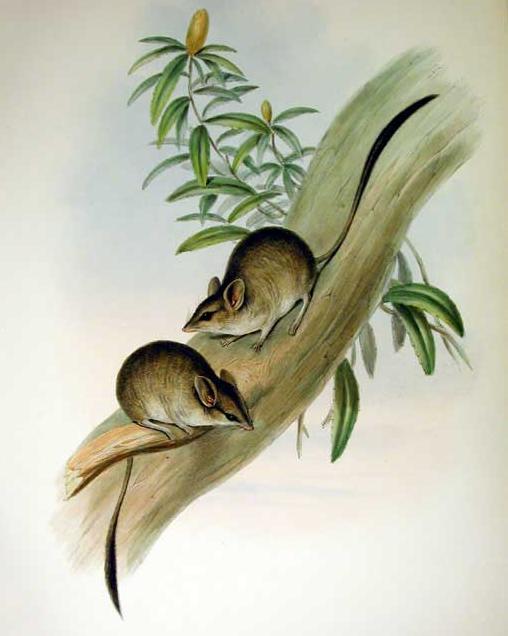- Kultarr
Taxobox
name = KultarrMSW3 Groves|pages=32]
status = LC
trend = decreasing
status_system = iucn3.1
status_ref = [IUCN2008|assessors=Morris, K., Woinarski, J., Ellis, M., Robinson, T. & Copley, P.|year=2008|id=1581|title=Antechinomys laniger|downloaded=09 October 2008]

image_caption =John Gould 's erroneous depiction of the Kultarr on a branch
regnum =Animal ia
phylum = Chordata
classis =Mammal ia
ordo =Dasyuromorphia
familia =Dasyuridae
subfamilia =Sminthopsinae
tribus =Sminthopsini
genus = "Antechinomys"
genus_authority = Krefft,1867
species = "A. laniger"
binomial = "Antechinomys laniger"
binomial_authority = (Gould,1856 )The Kultarr ("Antechinomys laniger"), also known as the Jerboa-marsupial, the Jerboa Pouched-mouse, the Wuhl-wuhl or the Pitchi-pitchi, is a member of the
Dasyuromorphia order. It is the only species in the "Antechinomys" genus. Native to central and southernAustralia , it lives in a range of habitats including scattered woodland and scrubby semidesert.Taxonomy
The Kultarr was described in 1856 by
John Gould , who placed it in the genus "Phascogale ". It was placed in thedunnart genus "Sminthopsis " for some time until it was confirmed, on the basis of molecular findings, that it belonged in its own genus, "Antechinomys" (meaning "antechinus -mouse"), which had been described by Gerard Krefft in 1867. Its other common names refer to its superficial similarity tojerboa s; the species has also been compared to theAustralia n hopping mice.The Kultarr has often been considered as two species in the past, "A. laniger" in the east and "A. spenceri" in the west. The latter is now relegated to subspecific status. The species name "laniger" means "woolly".Citation|last=Valente|first=A.|year=1995|editor-last=Strahan|editor-first=Ronald|contribution=Kultarr|title=The Mammals of Australia|publisher=Reed Books|pages=57-58|isbn=0-7301-0484-2]
Description
The Kultarr usually measures 7-10cm, with a 10-15cm tail. It weighs 20-30g; males are larger and heavier than females. The most distinctive features are the large four-toed hind legs, enabling a hopping motion, and prominent ears. It is coloured fawn grey to sandy brown above, with a white chest and darker eye-ring.
The Kultarr is a solitary
carnivore , feeding mostly on terrestrialinvertebrate s includingcockroach es,spider s and crickets. Mating occurs in winter and spring, with young being born around August-November. The species nests in soil cracks or utilises abandoned burrows of other species.Distribution and habitat
The Kultarr is an uncommon species found throughout much of arid
Australia , although its range has decreased in recent years. Isolated populations at Cedar Bay inQueensland and in southernNew South Wales are believed to be extinct.Kultarrs are found in arid
gibber plains, claypans and sandy desert; isolated populations have inhabitatedsaltmarsh .cite book|first=Peter|last=Menkhorst|year=2001|title=A Field Guide to the Mammals of Australia|pages=58|publisher=Oxford University Press|isbn=0-19-550870-X]References
Wikimedia Foundation. 2010.
